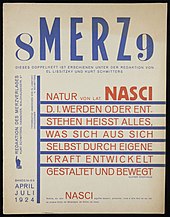Merz (term of art)
The term Merz is a synonym for the more commonly used term Dada , with which Hugo Ball , the founder of Cabaret Voltaire , founded in Zurich in 1916 , referred to the new art direction he and his colleagues were aiming for - Dadaism .
Concept history
The made-up word “Merz” itself goes back to Kurt Schwitters , the initiator of the Dada section in Hanover , who was in close contact with the Zurich Dadaists Hugo Ball , Hans Arp , Raoul Hausmann , Emmy Hennings and Tristan Tzara , among the Berlin Dadadists - especially with Richard Huelsenbeck - but met with rejection because of his middle-class habitus . When he was not admitted by them to the First International Dada Fair in Berlin in 1920, Schwitters thought of an "absolutely individual hat that only fit on a single head" - his own.
As luck would have it, when designing a collage he cut up the advert with the word Commerce in it so that only the syllable Merz remained, which allowed rhymes like “joke”, “mink” and “heart” to be associated and one similar senseless trait like Dada possessed. It became Schwitters' very own synonym for Dada.
From then on, Schwitters's entire artistic work, regardless of whether it was collages, paintings, poems, objects or drawings, was always carried out under the keyword Merz. Even the magazine he published at irregular intervals was called Merz. The Merzbau, a grotto-like collage sculpture with memorabilia, which Schwitters worked on for around twenty years in his house in Hanover, was gradually destroyed in one of the air raids on Hanover . A reconstruction of this incunable of modern art from the 1920s can be seen in the Sprengel Museum in Hanover .
reception
In addition, Schwitters's intellectual legacy is kept alive, for example through the matinee "Kurt Schwitters is Merz", celebrated by Ursula Neufeld in the Hamburg Galeria-Passage - in the spirit of the honored - on the occasion of an "out of round", namely his 99th birthday to which an illustrated brochure with the appropriate title “MERZimMÄRZ” came out. After the hits of the 1920s running off the tape had faded, the media theorist Michael Erlhoff gave a brief introduction to the life and work of the jubilee. Actor and author Klaus Pohl presented the theater maker Schwitters in a grotesque way with the mini-scene "The Zoo Bear", while Bernd Rauschenbach , otherwise Secretary of the Arno Schmidt Foundation , skillfully celebrated his famous Ursonate . “There are no types of art, they have been artificially separated from one another,” Schwitters once said. Natias Neutert , who came very close to Schwitters as a juggler and scholar, as a poet and thinker, reciter and enchanter , kept to this slogan . He illustrated the Dadaist poetics with an advertising slogan, before he staged himself with idiosyncratic poems.
2012 marked the anniversary of a dark chapter in his life in connection with Schwitters: It was 75 years ago that he had to flee from the Gestapo to Norway in 1937 and then to England in 1940 after the National Socialists had branded his work as “ degenerate art ” in 1933 , where he died on January 8, 1948 in Ambleside . In the meantime he has long been lying in the cemetery in his hometown that plays an important role in his satirical play Das Familiengrab . His gravestone bears the motto "You never know."
His hometown Hanover honors him by the fact that a state high school has been named after him. In addition, the joint library of the Hanover University of Music, Drama and Media and the library in the Kurt Schwitters Forum of the Hanover University of Applied Sciences at the EXPO Plaza bear his name. The square in front of the Sprengel Museum is also named after him, the rooms of which house many of his exhibits. Posthumously, documenta 1 (1955), documenta II (1959) and documenta III (1964) in Kassel also honored him and offered a concentrated selection from his diverse oeuvre.
Individual evidence
- ↑ Cf. Hugo Ball : When I founded the Cabaret Voltaire ... and The First Dadaist Manifesto (Zurich, July 14, 1916). Both in Hugo Ball : the artist and the sickness of time. Selected writings . Frankfurt a. M., pp. 37-40.
- ↑ And this, although the sentence "The Dadaist has the freedom [...] he can represent any 'art direction'" comes from him. See Richard Huelsenbeck (ed.): Dada Almanach. On behalf of the Central Office of the German Dada Movement, Berlin 1920. Unchanged reprint in Edition Nautilus, Verlag Lutz Schulenburg, Hamburg 1980, p. 9.
- ↑ Ernst Nündel: Kurt Schwitters in personal testimonials and image documents, Rowohlt's Monographs 296, Reinbek bei Hamburg 1981, p. 19 f., ISBN 3-499-50296-8 .
- ↑ Kurt Schwitters 1887–1948 . Frankfurt am Main / Berlin 1986, ISBN 3-549-06667-8 .
- ↑ Natias Neutert (ed.): Merzim März . Edition Boa Vista, Hamburg 1986.
- ↑ See Hannoversche Allgemeine Zeitung of March 27, 1986.
Web links
- Gwendolen Webster: The Reception of the Merzbau. (PDF; 7092 kB)


